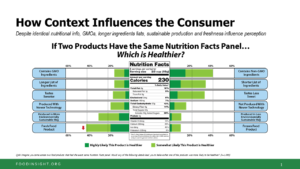
Among the multitude of “bright light” labels on food items, we have to decide what is best for our own health as well as for our family when making choices. But beyond our own taste and price parameters, whose standards do we follow? Do we make our food choices, like gifts, based on labels with which we are familiar or fit our social norms? Are labels pure marketing or can they provide important guidance for our personal health and safety? What influences our purchases?
All Labels Are Not Created Equal
According to the 2019 IFIC Foundation Food & Health Survey, only 28 percent of consumers stated that labeling did not influence their food purchasing habits, indicating that what we see and believe does affect what we buy. The term “natural” was identified by 40 percent of consumers as a key influence factor. In the same survey, consumers were asked to look at an identical Nutrition Fact Panel and evaluate its nutritional value based on six characteristics: GMO ingredients, ingredient list, sweetness, use of technology, environmentally sustainable production and form of product. Of the group, 40 percent believed if a product was fresh and non-GMO it was healthier, while close to 30 percent identified a shorter ingredient list, less sweetness and more environmentally sustainable production as contributing to the nutritional value of the product…and they were looking at the same label! This is a good example of where perception and reality can clash.
My Top 5 Label “Glitz” Misnomers
Whether it’s clothes, gifts or food, labels do influence our purchases. But we want to be smart about what we buy. Here are my top five “glitz” labels to be wary of:
- Natural – No formal definition of this term exists, but the FDA is reviewing it. Longstanding FDA policy considers the term to mean that nothing artificial or synthetic (including all color additives regardless of source) has been included in, or has been added to, a food that would not normally be expected to be in that food. However, “natural” does not define the nutritional benefits, health claims or the production or processing of a food product.
- Healthy – Again, this is a term we use often but is not regulated. The FDA started a public process in 2017 to redefine the “healthy” nutrient content claim for food labeling. This was part of an overall plan to provide consumers with consistent information to make good food choices, but no final rule exists today. With volumes of comments and research insights to mull over, no immediate decision is expected.
- Fresh – The definition of “fresh” may be more individual perception than regulation, which creates more questions than answers. Does “fresh orange juice” mean fresh-squeezed prior to serving or could it be from a purchased source? Are fresh fruits and vegetables only those bought in whole form? The FDA only defines the term “fresh-cut produce” as being physically altered from its whole state after being harvested from the field. From a nutritional standpoint, canned tomatoes or frozen blueberries may be more nutritious this time of the year as they were packed at the point of harvest and most of us are not harvesting fruits and vegetables from our backyard in the winter! The nutritional value of fresh produce can diminish during transportation across the U.S. or globally so “fresh” is not always best. One of my earlier blogs provides more insight on this topic.
- Local – This term describes only the direct or intermediated marketing of food to consumers produced and distributed in a limited geographic area. Actually, there is no pre-determined distance that defines what may be considered “local,” but a set number of miles from a center point or state/local boundaries is often used with a “100 miles” as a reference point. The ultimate goal of local is the “farm to table” connection. Based on the type of food purchased, production methods and distance of transportation, a local food may be more nutritious but there is no current labeling to define this.
- Non-GMO – This is a term that is practically on everything…and it’s true. But the reality is there are no genetically engineered “sister” products for the majority of our food. There only 10 commercially available GMO crops that exist today in the U.S. food supply: corn, soy, papaya, squash, canola, sugar beets, cotton, alfalfa, potato and apples. The frequently seen non-GMO “butterfly” is not government regulated but a symbol of a nonprofit organization “committed to preserving and building sources of non-GMO products, educating consumers and providing verified non-GMO choices.” Food companies must meet strict guidelines established by the organization to display the symbol. So if you see the symbol, you can be confident the product has been verified. But it is not a “health halo.”

Our dog Newt waiting to unwrap his gifts under the Christmas tree
Stick with the Basics
Food labels, like beautifully wrapped packages, may not always reveal what we need the most. Even though the latest gadget or “flashy” label attracts us, it’s really the “socks and underwear” mentality that we need when making the best food choices for our health. Stick with the basics: use the Nutrition Fact Panel, buy a variety of healthful foods from dairy to vegetables, and use the best food handling practices at home. Some things just never go out of style!
Notes:
Want more information about understanding food labels? Check out the new book Food Bullying: How To Avoid Buying B.S. by Michele Payn, available on Amazon.

